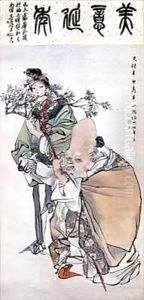Ren Bonian Paintings
Ren Bonian, also known as Ren Yi, was a prominent Chinese painter during the Qing Dynasty, celebrated for his contributions to the Shanghai School of painting. Born in 1840 in Xiaoshan, Zhejiang Province, Ren moved to Shanghai in 1862, where he became a key figure in the city's art scene, which was a significant cultural hub in 19th-century China. His work is characterized by a blend of traditional Chinese painting techniques with innovative approaches that reflected the dynamic changes of his time.
Ren Bonian's artistic journey began under the tutelage of his uncle, Ren Xiong, who was also a respected artist. This early mentorship provided him with a solid foundation in the classical styles of Chinese painting. However, it was Ren Bonian's ability to adapt and innovate beyond traditional boundaries that set his work apart. He was known for his vivid portrayal of figures, landscapes, and flowers, employing a bold and expressive style that incorporated vibrant colors and fluid brushwork. His figure paintings, in particular, are noted for their lively realism and emotional depth, often depicting scenes from everyday life with a remarkable level of detail and sensitivity.
Throughout his career, Ren Bonian was actively involved in the intellectual and artistic circles of Shanghai, which allowed him to engage with a wide range of artistic influences. This cosmopolitan environment, coupled with his natural talent and curiosity, led him to experiment with new subjects and techniques. Despite the Western influences that permeated Shanghai during the late Qing Dynasty, Ren's work remained deeply rooted in the Chinese artistic tradition, demonstrating his respect for his cultural heritage while also embracing change and innovation.
Ren Bonian's legacy extends beyond his contributions to the Shanghai School; he played a crucial role in the transformation of Chinese art during a period of significant social and political upheaval. His works are celebrated for their historical significance and artistic merit, providing insight into the cultural dynamics of 19th-century China. Ren Bonian passed away in 1896, leaving behind a body of work that continues to be admired for its originality, expressive power, and enduring beauty. Today, his paintings are held in high esteem, featured in museum collections worldwide, and serve as a source of inspiration for artists and art lovers alike.
